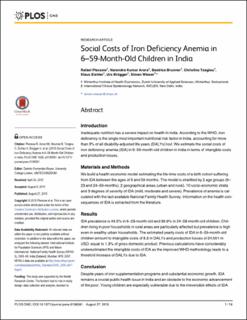Please use this identifier to cite or link to this item:
https://doi.org/10.21256/zhaw-4672Full metadata record
| DC Field | Value | Language |
|---|---|---|
| dc.contributor.author | Plessow, Rafael | - |
| dc.contributor.author | Arora, Narendra Kumar | - |
| dc.contributor.author | Brunner, Beatrice | - |
| dc.contributor.author | Tzogiou, Christina | - |
| dc.contributor.author | Eichler, Klaus | - |
| dc.contributor.author | Brügger, Urs | - |
| dc.contributor.author | Wieser, Simon | - |
| dc.date.accessioned | 2018-08-17T06:33:52Z | - |
| dc.date.available | 2018-08-17T06:33:52Z | - |
| dc.date.issued | 2015 | - |
| dc.identifier.issn | 1932-6203 | de_CH |
| dc.identifier.uri | https://digitalcollection.zhaw.ch/handle/11475/9050 | - |
| dc.description.abstract | Introduction: Inadequate nutrition has a severe impact on health in India. According to the WHO, iron deficiency is the single most important nutritional risk factor in India, accounting for more than 3% of all disability-adjusted life years (DALYs) lost. We estimate the social costs of iron deficiency anemia (IDA) in 6-59-month-old children in India in terms of intangible costs and production losses. Materials and Methods: We build a health economic model estimating the life-time costs of a birth cohort suffering from IDA between the ages of 6 and 59 months. The model is stratified by 2 age groups (6-23 and 24-59-months), 2 geographical areas (urban and rural), 10 socio-economic strata and 3 degrees of severity of IDA (mild, moderate and severe). Prevalence of anemia is calculated with the last available National Family Health Survey. Information on the health consequences of IDA is extracted from the literature. Results: IDA prevalence is 49.5% in 6-23-month-old and 39.9% in 24-58-month-old children. Children living in poor households in rural areas are particularly affected but prevalence is high even in wealthy urban households. The estimated yearly costs of IDA in 6–59-month-old children amount to intangible costs of 8.3 m DALYs and production losses of 24,001 m USD, equal to 1.3% of gross domestic product. Previous calculations have considerably underestimated the intangible costs of IDA as the improved WHO methodology leads to a threefold increase of DALYs due to IDA. Conclusion: Despite years of iron supplementation programs and substantial economic growth, IDA remains a crucial public health issue in India and an obstacle to the economic advancement of the poor. Young children are especially vulnerable due to the irreversible effects of IDA on cognitive development. Our research may contribute to the design of new effective interventions aiming to reduce IDA in early childhood. | de_CH |
| dc.language.iso | en | de_CH |
| dc.publisher | Public Library of Science | de_CH |
| dc.relation.ispartof | PLOS ONE | de_CH |
| dc.rights | http://creativecommons.org/licenses/by/4.0/ | de_CH |
| dc.subject | Iron-deficiency anemia | de_CH |
| dc.subject | Public health | de_CH |
| dc.subject | Quality-adjusted life years | de_CH |
| dc.subject | Risk factors | de_CH |
| dc.subject | Rural population | de_CH |
| dc.subject | Cost of illness | de_CH |
| dc.subject.ddc | 362.1041: Gesundheitsökonomie | de_CH |
| dc.title | Social costs of iron deficiency anemia in 6–59-month-old children in India | de_CH |
| dc.type | Beitrag in wissenschaftlicher Zeitschrift | de_CH |
| dcterms.type | Text | de_CH |
| zhaw.departement | School of Management and Law | de_CH |
| zhaw.organisationalunit | Winterthurer Institut für Gesundheitsökonomie (WIG) | de_CH |
| dc.identifier.doi | 10.21256/zhaw-4672 | - |
| dc.identifier.doi | 10.1371/journal.pone.0136581 | de_CH |
| dc.identifier.pmid | 26313356 | de_CH |
| zhaw.funding.eu | No | de_CH |
| zhaw.issue | 8 | de_CH |
| zhaw.originated.zhaw | Yes | de_CH |
| zhaw.pages.end | 16 | de_CH |
| zhaw.pages.start | 1 | de_CH |
| zhaw.publication.status | publishedVersion | de_CH |
| zhaw.volume | 10 | de_CH |
| zhaw.publication.review | Peer review (Publikation) | de_CH |
| zhaw.funding.zhaw | Burden of micronutrient deficiencies and cost-effectiveness of interventions with fortified foods | de_CH |
| Appears in collections: | Publikationen School of Management and Law | |
Files in This Item:
| File | Description | Size | Format | |
|---|---|---|---|---|
| journal.pone.0136581(1).PDF | 922.73 kB | Adobe PDF |  View/Open |
Show simple item record
Plessow, R., Arora, N. K., Brunner, B., Tzogiou, C., Eichler, K., Brügger, U., & Wieser, S. (2015). Social costs of iron deficiency anemia in 6–59-month-old children in India. Plos One, 10(8), 1–16. https://doi.org/10.21256/zhaw-4672
Plessow, R. et al. (2015) ‘Social costs of iron deficiency anemia in 6–59-month-old children in India’, PLOS ONE, 10(8), pp. 1–16. Available at: https://doi.org/10.21256/zhaw-4672.
R. Plessow et al., “Social costs of iron deficiency anemia in 6–59-month-old children in India,” PLOS ONE, vol. 10, no. 8, pp. 1–16, 2015, doi: 10.21256/zhaw-4672.
PLESSOW, Rafael, Narendra Kumar ARORA, Beatrice BRUNNER, Christina TZOGIOU, Klaus EICHLER, Urs BRÜGGER und Simon WIESER, 2015. Social costs of iron deficiency anemia in 6–59-month-old children in India. PLOS ONE. 2015. Bd. 10, Nr. 8, S. 1–16. DOI 10.21256/zhaw-4672
Plessow, Rafael, Narendra Kumar Arora, Beatrice Brunner, Christina Tzogiou, Klaus Eichler, Urs Brügger, and Simon Wieser. 2015. “Social Costs of Iron Deficiency Anemia in 6–59-Month-Old Children in India.” Plos One 10 (8): 1–16. https://doi.org/10.21256/zhaw-4672.
Plessow, Rafael, et al. “Social Costs of Iron Deficiency Anemia in 6–59-Month-Old Children in India.” Plos One, vol. 10, no. 8, 2015, pp. 1–16, https://doi.org/10.21256/zhaw-4672.
Items in DSpace are protected by copyright, with all rights reserved, unless otherwise indicated.